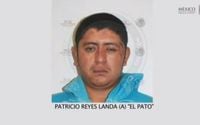The body of Patricio Reyes Landa, known as "El Pato," a presumed hitman linked to the notorious disappearance of the 43 Ayotzinapa students, was found dead this past weekend in a residence in Jilotepec, located in the northern part of the State of Mexico. Authorities discovered the body on Saturday, June 14, 2025, in the San Juan Acazuchitlán neighborhood, marking a grim chapter in the ongoing saga surrounding one of Mexico's most haunting criminal cases.
According to official reports, Reyes Landa was intercepted in the early hours of that Saturday morning by three men wearing balaclavas who forcibly entered his home. Witnesses present at the scene were instructed to leave, and after several hours, the victim's body was found bearing multiple injuries. Scattered around the scene were various shell casings and other evidentiary elements, suggesting a violent confrontation. The identities and whereabouts of the attackers remain unknown, and investigators are actively pursuing leads to uncover both the perpetrators and the motive behind this killing.
Patricio Reyes Landa’s name is deeply entangled with the dark events surrounding the disappearance of the 43 students from the Ayotzinapa Rural Teachers’ College in Guerrero state in 2014. He was initially arrested that same year for his alleged ties to the Guerreros Unidos cartel, a criminal organization widely implicated in the abduction and presumed murder of the students. Following his arrest, Reyes Landa reportedly provided valuable information to authorities, contributing to the strengthening of the investigation into the case.
However, the legal journey of "El Pato" has been fraught with complexity and controversy. In 2018, he was released after it was argued that his testimony had been extracted under torture. This revelation led to the dismissal of charges against him, which included organized crime involvement and kidnapping. The court's decision underscored the murky challenges faced by Mexico's justice system in prosecuting high-profile cartel-related cases, where evidence and confessions can be tainted by coercion.
Despite his release, Reyes Landa was recaptured in 2019 on separate charges related to firearm possession but was again freed in 2021. This cycle of arrests and releases paints a picture of ongoing instability and the difficulties in securing lasting convictions against individuals linked to powerful criminal networks.
Adding further layers to the Ayotzinapa tragedy, another alleged accomplice, Juan Miguel "El Pajarraco," was arrested for organized crime and forced disappearance charges connected to the same case nearly eleven years after the initial incident. Notably, in 2021, "El Pajarraco" declared that the search for the missing students should cease, claiming they had all perished after being incinerated at the Cocula landfill—a statement that has fueled ongoing debates and anguish among families and human rights advocates.
The killing of "El Pato" in the State of Mexico reignites painful memories and raises pressing questions about the safety and accountability of those involved in this decades-long saga. The fact that Reyes Landa was found murdered in a violent manner, with his assailants still at large, highlights the pervasive climate of impunity and danger surrounding cartel-related figures, even those who once cooperated with authorities.
Authorities have launched an active investigation to identify the hooded men responsible for the attack and to understand the motive behind the murder. Whether this act is connected to internal cartel disputes, retaliation for his past cooperation with law enforcement, or other criminal dynamics remains to be seen. For now, the chilling circumstances surrounding "El Pato's" death add yet another chapter of violence and mystery to the enduring Ayotzinapa case.
As the search for truth and justice continues for the families of the 43 disappeared students, the murder of a key figure linked to the case serves as a stark reminder of the dangers faced by those enmeshed in Mexico’s complex web of organized crime and corruption. It also underscores the challenges faced by the Mexican justice system in delivering closure and accountability in one of the country’s most emblematic and tragic criminal investigations.




